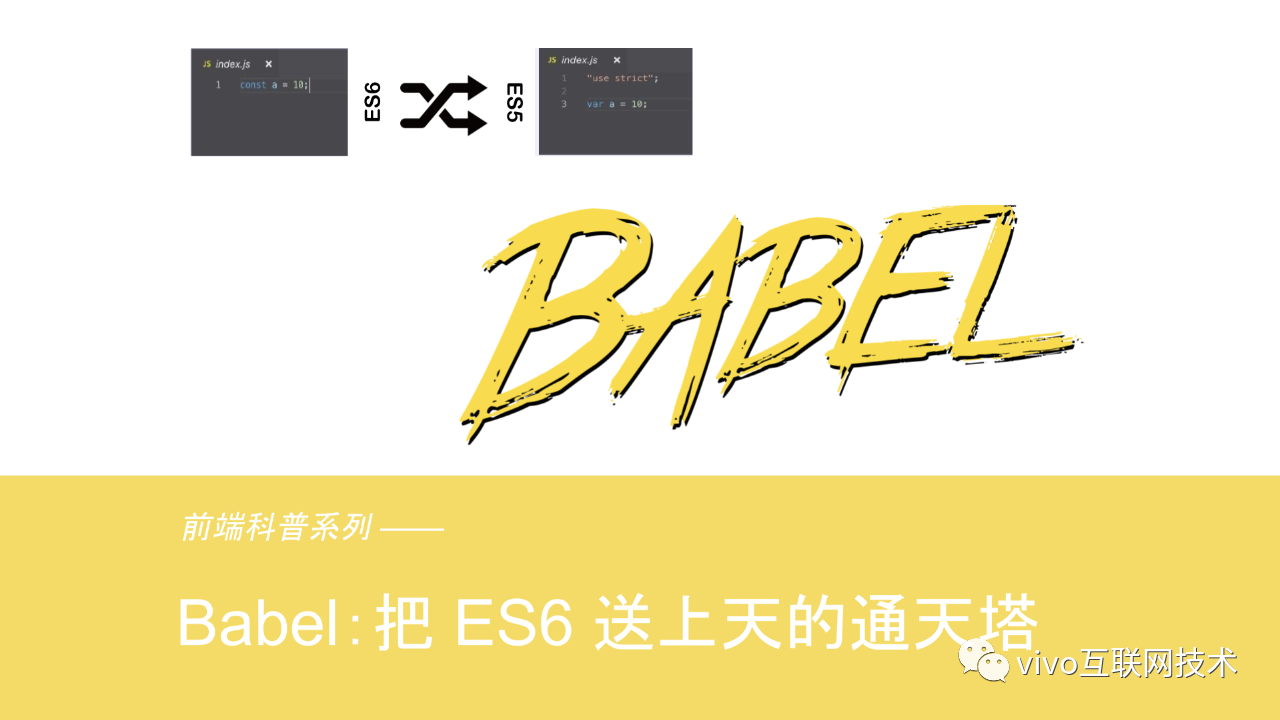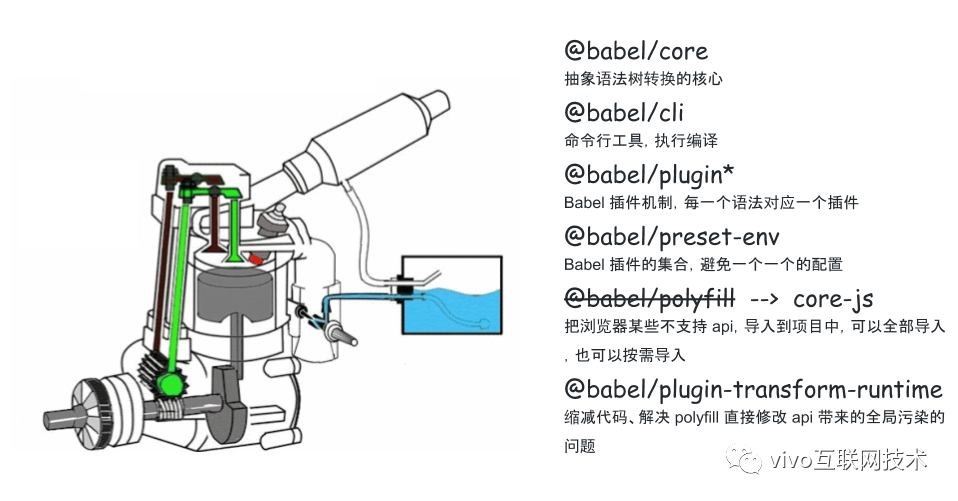本文首发于 vivo互联网技术 微信公众号
链接: https://mp.weixin.qq.com/s/plJewhUd0xDXh3Ce4CGpHg
作者:Morrain

一、前言
在上一节 《CommonJS:不是前端却革命了前端》中,我们聊到了 ES6 Module,它是 ES6 中对模块的规范,ES6 是 ECMAScript 6.0 的简称,泛指 JavaScript 语言的下一代标准,它的第一个版本 ES2015 已经在 2015 年 6 月正式发布,本文中提到的 ES6 包括 ES2015、ES2016、ES2017等等。在第一节的《Web:一路前行一路忘川》中也提到过,ES2015 从制定到发布历经了十几年,引入了很多的新特性以及新的机制,浏览器对 ES6 的支持进度远远赶不上前端开发小哥哥们使用 ES6 的热情,于是矛盾就日益显著……
二、Babel 是什么
先来看下它在官网上的定义:
Babel is a JavaScript compiler
没错就一句话,Babel 是 JavaScript 的编译器。至于什么是编译器,可以参考the-super-tiny-compiler这个项目,可以找到很好的答案。
本文是以 Babel 7.9.0 版本进行演示和讲解的,另外建议学习者阅读英文官网,中文官网会比原版网站慢一个版本,并且很多依然是英文的。
Babel 就是一套解决方案,用来把 ES6 的代码转化为浏览器或者其它环境支持的代码。注意我的用词哈,我说的不是转化为 ES5 ,因为不同类型以及不同版本的浏览器对 ES6 新特性的支持程度都不一样,对于浏览器已经支持的部分,Babel 可以不转化,所以 Babel 会依赖浏览器的版本,后面会讲到。这里可以先参考browerslist项目。
Babel 的历史
在学习任何一门知识前,我都习惯先了解它的历史,这样才能深刻理解它存在意义。
Babel 的作者是 FaceBook 的工程师 Sebastian McKenzie。他在 2014 年发布了一款 JavaScript 的编译器 6to5。从名字就能看出来,它主要的作用就是将 ES6 转化为 ES5。
这里的 ES6 指 ES2015,因为当时还没有正式发布, ES2015 的名字还未被正式确定。
于是很多人评价,6to5 只是 ES6 得到支持前的一个过渡方案,它的作者非常不同意这个观点,认为 6to5 不光会按照标准逐步完善,依然具备非常大的潜力反过来影响并推进标准的制定。正因为如此 6to5 的团队觉得 '6to5' 这个名字并没有准确的传达这个项目的目标。加上 ES6 正式发布后,被命名为 ES2015,对于 6to5 来说更偏离了它的初衷。于是 2015 年 2 月 15 号,6to5 正式更名为 Babel。

(图片来源于网络)
Babel 是巴比伦文化里的通天塔,用来给 6to5 这个项目命名真得太贴切了!羡慕这些牛逼的人,不光代码写得好,还这么有文化,不像我们,起个变量名都得憋上半天,吃了没有文化的亏。这也是为什么我把这篇文章起名为 《Babel:把 ES6 送上天的通天塔》的原因。
三、Babel 怎么用
了解了 Babel 是什么后,很明显我们就要开始考虑怎么使用 Babel 来转化 ES6 的代码了,除了 Babel 本身提供的 cli 等工具外,它还支持和其它打包工具配合使用,譬如 webpack、rollup 等等,可以参考官网对不同平台提供的配置说明。
本文为了感受 Babel 最原始的用法,不结合其它任何工具,直接使用 Babel 的 cli 来演示。
1、构建 Babel 演示的工程
使用如下命令构建一个 npm 包,并新建 src 目录 和 一个 index.js 文件。
npm init -y

package.json 内容如下:
{
"name": "demo",
"version": "1.0.0",
"description": "",
"main": "index.js",
"scripts": {
"test": "echo \"Error: no test specified\" && exit 1"
},
"keywords": [],
"author": "",
"license": "ISC"
}2、安装依赖包
npm install --save-dev @babel/core @babel/cli @babel/preset-env后面会介绍这些包的作用,先看用法
增加 babel 命令来编译 src 目录下的文件到 dist 目录:
{
"name": "demo",
"version": "1.0.0",
"description": "",
"main": "src/index.js",
"scripts": {
"babel": "babel src --out-dir dist",
"test": "echo \"Error: no test specified\" && exit 1"
},
"keywords": [],
"author": "",
"license": "ISC",
"devDependencies": {
"@babel/cli": "^7.8.4",
"@babel/core": "^7.9.0",
"@babel/preset-env": "^7.9.0"
}
}3、增加 Babel 配置文件
在工程的根目录添加 babel.config.js 文件,增加 Babel 编译的配置,没有配置是不进行编译的。
const presets = [
[
'@babel/env',
{
debug: true
}
]
]
const plugins = []
module.exports = { presets, plugins }上例中 debug 配置是为了打印出 Babel 工作时的日志,可以方便的看来,Babel 转化了哪些语法。
- presets 主要是配置用来编译的预置,plugins 主要是配置完成编译的插件,具体的含义后面会讲
- 推荐用 Javascript 文件来写配置文件,而不是 JSON 文件,这样可以根据环境来动态配置需要使用的 presets 和 plugins
const presets = [
[
'@babel/env',
{
debug: true
}
]
]
const plugins = []
if (process.env["ENV"] === "prod") {
plugins.push(...)
}
module.exports = { presets, plugins }4、编译的结果
配置好后,我们运行 npm run babel 命令,可以看到 dist 文件夹下生成了 index.js 文件,内容如下所示:
// src/index.js
const add = (a, b) => a + b
// dist/index.js
"use strict";
var add = function add(a, b) {
return a + b;
};可以看到,ES6 的 const 被转化为 var ,箭头函数被转化为普通函数。同时打印出来如下日志:
> babel src --out-dir dist
@babel/preset-env: `DEBUG` option
Using targets:
{}
Using modules transform: auto
Using plugins:
proposal-nullish-coalescing-operator {}
proposal-optional-chaining {}
proposal-json-strings {}
proposal-optional-catch-binding {}
transform-parameters {}
proposal-async-generator-functions {}
proposal-object-rest-spread {}
transform-dotall-regex {}
proposal-unicode-property-regex {}
transform-named-capturing-groups-regex {}
transform-async-to-generator {}
transform-exponentiation-operator {}
transform-template-literals {}
transform-literals {}
transform-function-name {}
transform-arrow-functions {}
transform-block-scoped-functions {}
transform-classes {}
transform-object-super {}
transform-shorthand-properties {}
transform-duplicate-keys {}
transform-computed-properties {}
transform-for-of {}
transform-sticky-regex {}
transform-unicode-regex {}
transform-spread {}
transform-destructuring {}
transform-block-scoping {}
transform-typeof-symbol {}
transform-new-target {}
transform-regenerator {}
transform-member-expression-literals {}
transform-property-literals {}
transform-reserved-words {}
transform-modules-commonjs {}
proposal-dynamic-import {}
Using polyfills: No polyfills were added, since the `useBuiltIns` option was not set.
Successfully compiled 1 file with Babel.四、Babel 工作原理
在了解了如何使用后,我们一起来探寻一下编译背后的事情,同时会熟悉 Babel 的组成和进阶用法。
1、Babel 工作流程
前面提到 Babel 其实就是一个纯粹的 JavaScript 的编译器,任何一个编译器工作流程大致都可以分为如下三步:
-
Parser 解析源文件
-
Transfrom 转换
- Generator 生成新文件
Babel 也不例外,如下图所示:

(图片来源于网络)
因为 Babel 使用是acorn这个引擎来做解析,这个库会先将源码转化为抽象语法树 (AST),再对 AST 作转换,最后将转化后的 AST 输出,便得到了被 Babel 编译后的文件。
那 Babel 是如何知道该怎么转化的呢?答案是通过插件,Babel 为每一个新的语法提供了一个插件,在 Babel 的配置中配置了哪些插件,就会把插件对应的语法给转化掉。插件被命名为 @babel/plugin-xxx 的格式。
2、Babel 组成

(1)@babel/preset-env
上面提到过 @babel/preset-* 其实是转换插件的集合,最常用的就是 @babel/preset-env,它包含了 大部分 ES6 的语法,具体包括哪些插件,可以在 Babel 的日志中看到。如果源码中使用了不在 @babel/preset-env 中的语法,会报错,手动在 plugins 中增加即可。
例如 ES6 明确规定,Class 内部只有静态方法,没有静态属性。但现在有一个提案提供了类的静态属性,写法是在实例属性的前面,加上 static 关键字。
// src/index.js
const add = (a, b) => a + b
class Person {
static a = 'a';
static b;
name = 'morrain';
age = 18
}编译时就会报如下错误:


根据报错的提示,添加 @babel/plugin-proposal-class-properties 即可。
npm install --save-dev @babel/plugin-proposal-class-properties// babel.config.js
const presets = [
[
'@babel/env',
{
debug: true
}
]
]
const plugins = ['@babel/plugin-proposal-class-properties']
module.exports = { presets, plugins }@babel/preset-env 中还有一个非常重要的参数 targets,最早的时候我们就提过,Babel 转译是按需的,对于环境支持的语法可以不做转换的。就是通过配置 targets 属性,让 Babel 知道目标环境,从而只转译环境不支持的语法。如果没有配置会默认转译所有 ES6 的语法。
// src/index.js
const add = (a, b) => a + b
// dist/index.js 没有配置targets
"use strict";
var add = function add(a, b) {
return a + b;
};按如下配置 targets
// babel.config.js
const presets = [
[
'@babel/env',
{
debug: true,
targets: {
chrome: '58'
}
}
]
]
const plugins = ['@babel/plugin-proposal-class-properties']
module.exports = { presets, plugins }编译后的结果如下:
// src/index.js
const add = (a, b) => a + b
// dist/index.js 配置targets chrome 58
"use strict";
const add = (a, b) => a + b;可以看到 const 和箭头函数都没有被转译,因为这个版本的 chrome 已经支持了这些特性。可以根据需求灵活的配置目标环境。
为后方便后续的讲解,把 targets 的配置去掉,让 Babel 默认转译所有语法。
(2)@babel/polyfill
polyfill 直译是垫片的意思,又是 Babel 里一个非常重要的概念。先看下面几行代码:
// src/index.js
const add = (a, b) => a + b
const arr = [1, 2]
const hasThreee = arr.includes(3)
new Promise()按之前的方法,执行 npm run babel 后,我们惊奇的发现,Array.prototype.includes 和 Promise 竟然没有被转译!
// dist/index.js
"use strict";
var add = function add(a, b) {
return a + b;
};
var arr = [1, 2];
var hasThreee = arr.includes(3);
new Promise();原来 Babel 把 ES6 的标准分为 syntax 和 built-in 两种类型。syntax 就是语法,像 const、=> 这些默认被 Babel 转译的就是 syntax 的类型。而对于那些可以通过改写覆盖的语法就认为是 built-in,像 includes 和 Promise 这些都属于 built-in。而 Babel 默认只转译 syntax 类型的,对于 built-in 类型的就需要通过 @babel/polyfill 来完成转译。@babel/polyfill 实现的原理也非常简单,就是覆盖那些 ES6 新增的 built-in。示意如下:
Object.defineProperty(Array.prototype, 'includes',function(){
...
})由于 Babel 在 7.4.0 版本中宣布废弃 @babel/polyfill ,而是通过 core-js 替代,所以本文直接使用 core-js 来讲解 polyfill 的用法。
- 安装 core-js
npm install --save core-js- 注意 core-js 要使用 --save 方式安装,因为它是需要被注入到源码中的,在执行代码前提供执行环境,用来实现 built-in 的注入
-
配置 useBuiltIns
在 @babel/preset-env 中通过 useBuiltIns 参数来控制 built-in 的注入。它可以设置为 'entry'、'usage' 和 false 。默认值为 false,不注入垫片。
设置为 'entry' 时,只需要在整个项目的入口处,导入 core-js 即可。
// src/index.js
import 'core-js'
const add = (a, b) => a + b
const arr = [1, 2]
const hasThreee = arr.includes(3)
new Promise()
// dist/index.js
"use strict";
require("core-js/modules/es7.array.includes");
require("core-js/modules/es6.promise");
//
// …… 这里还有很多
//
require("regenerator-runtime/runtime");
var add = function add(a, b) {
return a + b;
};
var arr = [1, 2];
var hasThreee = arr.includes(3);
new Promise();- 编译后,Babel 会把目标环境不支持的所有 built-in 都注入进来,不管是不是用到,这有一个问题,对于只用到比较少的项目来说完全没有必要,白白增加代码,浪费包体大小。
设置为 'usage' 时,就不用在项目的入口处,导入 core-js了,Babel 会在编译源码的过程中根据 built-in 的使用情况来选择注入相应的实现。
// src/index.js
const add = (a, b) => a + b
const arr = [1, 2]
const hasThreee = arr.includes(3)
new Promise()
// dist/index.js
"use strict";
require("core-js/modules/es6.promise");
require("core-js/modules/es6.object.to-string");
require("core-js/modules/es7.array.includes");
var add = function add(a, b) {
return a + b;
};
var arr = [1, 2];
var hasThreee = arr.includes(3);
new Promise();- 配置 corejs 的版本
当 useBuiltIns 设置为 'usage' 或者 'entry' 时,还需要设置 @babel/preset-env 的 corejs 参数,用来指定注入 built-in 的实现时,使用 corejs 的版本。否则 Babel 日志输出会有一个警告。
最终的 Babel 配置如下:
// babel.config.js
const presets = [
[
'@babel/env',
{
debug: true,
useBuiltIns: 'usage',
corejs: 3,
targets: {}
}
]
]
const plugins = ['@babel/plugin-proposal-class-properties']
module.exports = { presets, plugins }(3)@babel/plugin-transform-runtime
在介绍 @babel/plugin-transform-runtime 的用途之前,先前一个例子:
// src/index.js
const add = (a, b) => a + b
const arr = [1, 2]
const hasThreee = arr.includes(3)
new Promise(resolve=>resolve(10))
class Person {
static a = 1;
static b;
name = 'morrain';
age = 18
}
// dist/index.js
"use strict";
require("core-js/modules/es.array.includes");
require("core-js/modules/es.object.define-property");
require("core-js/modules/es.object.to-string");
require("core-js/modules/es.promise");
function _classCallCheck(instance, Constructor) { if (!(instance instanceof Constructor)) { throw new TypeError("Cannot call a class as a function"); } }
function _defineProperty(obj, key, value) { if (key in obj) { Object.defineProperty(obj, key, { value: value, enumerable: true, configurable: true, writable: true }); } else { obj[key] = value; } return obj; }
var add = function add(a, b) {
return a + b;
};
var arr = [1, 2];
var hasThreee = arr.includes(3);
new Promise(function (resolve) {
return resolve(10);
});
var Person = function Person() {
_classCallCheck(this, Person);
_defineProperty(this, "name", 'morrain');
_defineProperty(this, "age", 18);
};
_defineProperty(Person, "a", 1);
_defineProperty(Person, "b", void 0);在编译的过程中,对于 built-in 类型的语法通过 require("core-js/modules/xxxx") polyfill 的方式来兼容,对于 syntax 类型的语法在转译的过程会在当前模块中注入类似 _classCallCheck 和 _defineProperty 的 helper 函数来实现兼容。对于一个模块而言,可能还好,但对于项目中肯定是很多模块,每个模块模块都注入这些 helper 函数,势必会造成代码量变得很大。
而 @babel/plugin-transform-runtime 就是为了复用这些 helper 函数,缩小代码体积而生的。当然除此之外,它还能为编译后的代码提供一个沙箱环境,避免全局污染。
使用 @babel/plugin-transform-runtime
- ①安装
npm install --save-dev @babel/plugin-transform-runtime
npm install --save @babel/runtime其中 @babel/plugin-transform-runtime 是编译时使用的,安装为开发依赖,而 @babel/runtime 其实就是 helper 函数的集合,需要被引入到编译后代码中,所以安装为生产依赖
- ②修改 Babel plugins 配置,增加@babel/plugin-transform-runtime
// babel.config.js
const presets = [
[
'@babel/env',
{
debug: true,
useBuiltIns: 'usage',
corejs: 3,
targets: {}
}
]
]
const plugins = [
'@babel/plugin-proposal-class-properties',
[
'@babel/plugin-transform-runtime'
]
]
module.exports = { presets, plugins }- 之前的例子,再次编译后,可以看到,之前的 helper 函数,都变成类似require("@babel/runtime/helpers/classCallCheck") 的实现了。
// dist/index.js
"use strict";
var _interopRequireDefault = require("@babel/runtime/helpers/interopRequireDefault");
require("core-js/modules/es.array.includes");
require("core-js/modules/es.object.to-string");
require("core-js/modules/es.promise");
var _classCallCheck2 = _interopRequireDefault(require("@babel/runtime/helpers/classCallCheck"));
var _defineProperty2 = _interopRequireDefault(require("@babel/runtime/helpers/defineProperty"));
var add = function add(a, b) {
return a + b;
};
var arr = [1, 2];
var hasThreee = arr.includes(3);
new Promise(function (resolve) {
return resolve(10);
});
var Person = function Person() {
(0, _classCallCheck2["default"])(this, Person);
(0, _defineProperty2["default"])(this, "name", 'morrain');
(0, _defineProperty2["default"])(this, "age", 18);
};
(0, _defineProperty2["default"])(Person, "a", 1);
(0, _defineProperty2["default"])(Person, "b", void 0);- 配置 @babel/plugin-transform-runtime
到目前为止,对于 built-in 类型的语法还是通过 require("core-js/modules/xxxx") polyfill 的方式来实现的,例如为了支持 Array.prototype.includes 方法,需要 require
("core-js/modules/es.array.includes") 在 Array.prototype 中添加 includes 方法来实现的,但这会导致一个问题,它是直接修改原型的,会造成全局污染。如果你开发的是独立的应用问题不大,但如果开发的是工具库,被其它项目引用,而恰好该项目自身实现了 Array.prototype.includes 方法,这样就出了大问题!而 @babel/plugin-transform-runtime 可以解决这个问题,只需要配置 @babel/plugin-transform-runtime 的参数 corejs。该参数默认为 false,可以设置为 2 或者 3,分别对应 @babel/runtime-corejs2 和 @babel/runtime-corejs3。
把 @babel/plugin-transform-runtime 的 corejs 的值设置为3,把 @babel/runtime 替换为 @babel/runtime-corejs3。
去掉 @babel/preset-env 的 useBuiltIns 和 corejs 的配置,去掉 core-js。因为使用 @babel/runtime-corejs3 来实现对 built-in 类型语法的兼容,不用再使用 useBuiltIns了。
npm uninstall @babel/runtime
npm install --save @babel/runtime-corejs3
npm uninstall core-js// babel.config.js
const presets = [
[
'@babel/env',
{
debug: true,
targets: {}
}
]
]
const plugins = [
'@babel/plugin-proposal-class-properties',
[
'@babel/plugin-transform-runtime',
{
corejs: 3
}
]
]
module.exports = { presets, plugins }
// dist/index.js
"use strict";
var _interopRequireDefault = require("@babel/runtime-corejs3/helpers/interopRequireDefault");
var _classCallCheck2 = _interopRequireDefault(require("@babel/runtime-corejs3/helpers/classCallCheck"));
var _defineProperty2 = _interopRequireDefault(require("@babel/runtime-corejs3/helpers/defineProperty"));
var _promise = _interopRequireDefault(require("@babel/runtime-corejs3/core-js-stable/promise"));
var _includes = _interopRequireDefault(require("@babel/runtime-corejs3/core-js-stable/instance/includes"));
var add = function add(a, b) {
return a + b;
};
var arr = [1, 2];
var hasThreee = (0, _includes["default"])(arr).call(arr, 3);
new _promise["default"](function (resolve) {
return resolve(10);
});
var Person = function Person() {
(0, _classCallCheck2["default"])(this, Person);
(0, _defineProperty2["default"])(this, "name", 'morrain');
(0, _defineProperty2["default"])(this, "age", 18);
};
(0, _defineProperty2["default"])(Person, "a", 1);
(0, _defineProperty2["default"])(Person, "b", void 0);可以看到 Promise 和 arr.includes 的实现已经变成局部变量,并没有修改全局上的实现。
3、Babel polyfill 实现方式的区别
截至目前为止,对于 built-in 类型的语法的 polyfill,一共有三种方式:
-
使用 @babel/preset-env ,useBuiltIns 设置为 'entry'
-
使用 @babel/preset-env ,useBuiltIns 设置为 'usage'
- 使用 @babel/plugin-transform-runtime
前两种方式支持设置 targets ,可以根据目标环境来适配。useBuiltIns 设置为 'entry' 会注入目标环境不支持的所有 built-in 类型语法,useBuiltIns 设置为 'usage' 会注入目标环境不支持的所有被用到的 built-in 类型语法。注入的 built-in 类型的语法会污染全局。
第三种方式目前不支持设置 targets,所以不会考虑目标环境是否已经支持,它是通过局部变量的方式实现了所有被用到的 built-in 类型语法,不会污染全局。
针对第三种方式不支持设置 targets 的问题,Babel 正在考虑解决,目前意向的方案是通过 Polyfill provider 来统一 polyfill 的实现:
-
废弃 @babel/preset-env 中 useBuiltIns 和 corejs 两个参数,不再通过 @babel/preset-env 实现 polyfill。
-
废弃 @babel/plugin-transform-runtime 中的 corejs 参数,也不再通过 @babel/plugin-transform-runtime 来实现 polyfill。
-
增加 polyfills 参数,类似于现在 presets 和 plugins,用来取代现在的 polyfill 方案。
- 把 @babel/preset-env 中 targets 参数,往上提一层,和 presets、plugins、polyfills 同级别,并由它们共享。
这个方案实现后,Babel 的配置会是下面的样子:
// babel.config.js
const targets = [
'>1%'
]
const presets = [
[
'@babel/env',
{
debug: true
}
]
]
const plugins = [
'@babel/plugin-proposal-class-properties'
]
const polyfills = [
[
'corejs3',
{
method: 'usage-pure'
}
]
]
module.exports = { targets, presets, plugins, polyfills }配置中的 method 值有 'entry-global'、'usage-global'、'usage-pure' 三种。
-
'entry-global' 等价于 @babel/preset-env 中的 useBuiltIns: 'entry'
-
'usage-global' 等价于 @babel/preset-env 中的 useBuiltIns: 'usage'
- 'usage-pure' 等价于 @babel/plugin-transform-runtime 中的 corejs
本文为了讲解方便,都是用 Babel 原生的 @babel/cli 来编译文件,实际使用中,更多的是结合 webpack、rollup 这样第三方的工具来使用的。
所以下一节,我们聊聊打包工具 webpack。
五、参考文献
来源:oschina
链接:https://my.oschina.net/u/4330568/blog/4412506